Handling Common Running Pains: Reasons, Solutions, and Avoidance
As joggers, we typically encounter numerous pains that can prevent our efficiency and enjoyment of this physical task. By exploring the root reasons for these operating pains, we can discover targeted options and preventive procedures to make sure a smoother and extra meeting running experience.
Common Running Pain: Shin Splints
Shin splints, a common running discomfort, frequently result from overuse or inappropriate shoes during exercise. This problem, medically understood as medial tibial stress disorder, manifests as pain along the internal side of the shinbone (shin) and prevails among professional athletes and joggers. The repetitive anxiety on the shinbone and the cells affixing the muscles to the bone causes swelling and discomfort. Joggers who rapidly enhance the strength or period of their exercises, or those that have level feet or inappropriate running strategies, are particularly vulnerable to shin splints.
To avoid shin splints, people should slowly increase the strength of their workouts, use ideal footwear with correct arch support, and preserve adaptability and strength in the muscle mass bordering the shin (running strategy). Additionally, incorporating low-impact tasks like swimming or biking can help preserve cardio fitness while allowing the shins to heal.
Typical Running Discomfort: IT Band Disorder
In addition to shin splints, one more common running discomfort that professional athletes frequently come across is IT Band Disorder, a condition triggered by swelling of the iliotibial band that leaves the external upper leg and knee. IT Band Disorder usually manifests as pain outside of the knee, particularly throughout tasks like running or biking. The iliotibial band is a thick band of fascia that links the aware of the shin, and when it ends up being irritated or limited, it can rub against the thigh bone, leading to discomfort and pain.
Joggers experiencing IT Band Disorder might notice a stinging or hurting experience on the external knee, which can get worse with ongoing activity. Elements such as overuse, muscle mass discrepancies, incorrect running type, or insufficient warm-up can contribute to the growth of this problem. To stop and relieve IT Band Disorder, joggers must concentrate on stretching and strengthening workouts for the hips and upper legs, appropriate footwear, steady training development, and resolving any type of biomechanical problems that may be aggravating the issue. Disregarding the symptoms of IT Band Disorder can bring about persistent issues and long term healing times, emphasizing the importance of very early intervention and correct monitoring methods.
Common Running Pain: Plantar Fasciitis

Plantar Fasciitis can be credited to various elements such as overtraining, incorrect footwear, working on difficult surfaces, or having high arches or flat feet. To stop and alleviate Plantar Fasciitis, joggers can integrate extending workouts for the calves and plantar fascia, wear encouraging shoes, preserve a healthy weight to lower stress on the feet, and progressively boost running intensity to stay clear of unexpected stress and anxiety on the plantar fascia. If symptoms continue, it is recommended to seek advice from a healthcare professional for proper diagnosis and treatment choices to resolve the problem efficiently.
Usual Running Pain: Runner's Knee
After resolving the difficulties of Plantar Fasciitis, another common issue that joggers commonly deal with is Jogger's Knee, a typical running pain that can impede athletic performance and cause pain throughout physical task. Jogger's Knee, likewise understood as patellofemoral pain syndrome, shows up as pain around or behind the kneecap. Runners experiencing this pain might really feel a boring, hurting discomfort while running, going up or down stairs, or after long term periods of sitting.
Typical Running Pain: Achilles Tendonitis
Frequently afflicting runners, Achilles Tendonitis is an agonizing condition that influences the Achilles ligament, creating discomfort and prospective limitations in exercise. The Achilles ligament is a thick band of tissue that attaches the calf bone muscles to the heel bone, crucial for activities like running, leaping, and strolling - check over here. Achilles Tendonitis often develops as a result of overuse, inappropriate shoes, insufficient extending, or abrupt rises in physical task
Signs And Symptoms of Achilles Tendonitis include pain and rigidity along the tendon, particularly in the morning or after periods of lack of exercise, swelling that gets worse with activity, and perhaps bone stimulates in persistent cases. To stop Achilles Tendonitis, it is important to stretch properly in the past and after running, use appropriate shoes with correct support, slowly boost the strength of exercise, and cross-train to reduce recurring tension on the ligament.
Verdict
